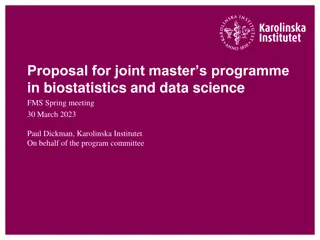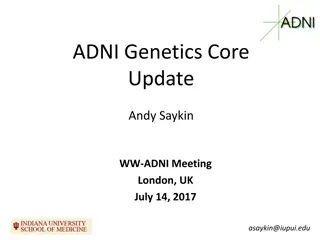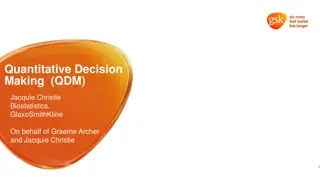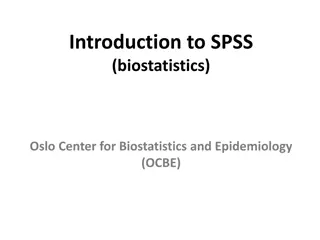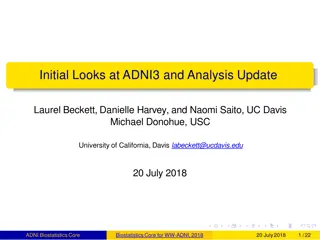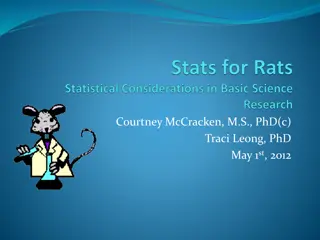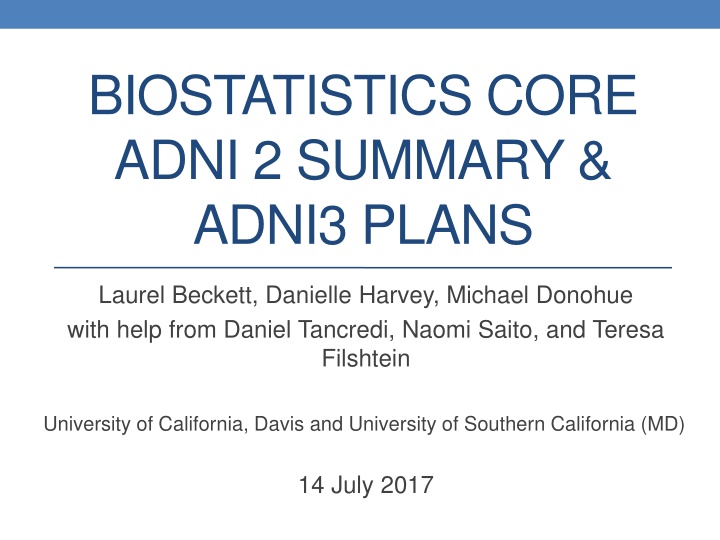
Biomarkers for Prediction and Progression in MCI and AD
This study delves into predictive biomarkers for progression from MCI to AD within 24 months, as well as changes in ADAS-Cog within MCI patients. Discover the top markers and their significance in clinical trial design and patient outcomes. Promising brain markers are identified for predicting cognitive decline, offering potential avenues for improved diagnosis and treatment strategies.
Download Presentation

Please find below an Image/Link to download the presentation.
The content on the website is provided AS IS for your information and personal use only. It may not be sold, licensed, or shared on other websites without obtaining consent from the author. If you encounter any issues during the download, it is possible that the publisher has removed the file from their server.
You are allowed to download the files provided on this website for personal or commercial use, subject to the condition that they are used lawfully. All files are the property of their respective owners.
The content on the website is provided AS IS for your information and personal use only. It may not be sold, licensed, or shared on other websites without obtaining consent from the author.
E N D
Presentation Transcript
BIOSTATISTICS CORE ADNI 2 SUMMARY & ADNI3 PLANS Laurel Beckett, Danielle Harvey, Michael Donohue with help from Daniel Tancredi, Naomi Saito, and Teresa Filshtein University of California, Davis and University of Southern California (MD) 14 July 2017
ADNI2 Results: Highlights The Biostatistics Core integrates data from all Cores to address implications for clinical trial design: Comparing candidate biomarkers for potential for inclusion/exclusion, stratification, adjustment Predictors of disease progression (to MCI or to AD) Predictors of cognitive and functional decline Comparing candidate biomarkers as outcome measures of change Signal-to-noise ratio of change over 1-2 years Correlation of change in biomarker with cognitive or functional change Characterizing sequence of change, especially in preclinical and early stages Identifying important subgroups in MCI
Predictors of progression from MCI to AD within 24 months Effect Size 1.19 1.06 1.00 0.93 0.92 0.91 0.87 0.71 0.38 0.30 0.22 Measures with highest effect size for predicting progression are at top Effect size: how many SD separate the means for those that progress and those that do not Measures sharing colored bar are not significantly different after multiple comparisons Marker FDG-R-UCB AV45-R-UCB Entr thickness Hpc vol CSF pTau CSF abeta CSF tau Entr vol Ventricles vol Whole brain vol W mat hyp
Predictors of change in ADAS-Cog in MCI (n=328) Many baseline markers correlated with increase in ADAS-Cog The same top 3 as for progression to AD Measures sharing colored bar are not different after multiple comparisons Marker FDG-R-UCB Entr thickness AV45-R-UCB CSF pTau CSF tau CSF abeta Hpc vol Ventricles vol Entr vol Whole brain vol Correlation p-value -0.32 -0.25 0.22 0.19 0.18 -0.15 -0.14 0.12 -0.09 <0.01 <0.01 <0.01 <0.01 <0.01 <0.01 <0.01 0.02 0.12 0.003 0.96
Promising biomarkers for prediction in MCI Three different brain markers have at least a 1-SD difference between the baseline means for those that progress and those that do not and also correlate (|r| 0.2) with ADAS-Cog change FDG-PET summary measure (UC Berkeley) AV45 cortical summary measure (UC Berkeley) Entorhinal cortex thickness (UCSF, FreeSurfer) These markers, singly or in combination, could be used to improve clinical trial design by: Inclusion of people more likely to progress Exclusion of people more likely to stay stable, or Stratifying by risk group
Assessing biomarkers in NC is harder Prediction of short-term progression to MCI is much weaker than MCI to AD Short-term change in ADAS-Cog is smaller and more variable, so harder to predict Instead, will see what does change
Signal-to-noise properties of 1-year change in NC Sample size required for 1-yr trial in NC to detect 25% reduction in change Best precision (smallest sample size) at bottom Measures sharing colored bar are not significantly different after multiple comparisons Marker CSF Abeta rate WMHYP rate AV45 rate Entr volume rate TOTAL13 rate Hippocampal vol rate CDR-sb rate MMSE rate CSF Tau rate CSF PTau rate Entr thickness rate Whole brain vol rate TBM rate Ventricles vol rate n/group 13546 7382 6873 3810 3223 3173 2880 1582 1548 1389 1130 947 516 397
Validating change in markers: correlation with ADAS-Cog change in NC (n=206) Increase in AV45 correlated with increase in ADAS- Cog No other association is significant Measures sharing colored bar are not significantly different after multiple comparisons Marker AV45-R-UCB Entr thickness Entr vol CSF abeta CSF ptau Hpc vol CSF tau FDG-R-UCB Ventricles vol Whole brain vol Correlation p-value 0.14 0.049 -0.12 -0.12 -0.08 0.08 -0.07 -0.06 0.05 -0.05 0.09 0.10 0.25 0.28 0.33 0.41 0.46 0.51 -0.03 0.64
Promising markers for prediction in NC Less consistent than in MCI Some imaging measures have promising signal- to-noise ratios Ventricular volume (FreeSurfer, UCSF) TBM (Mayo) Not as correlated with change in ADAS-Cog Change in AV45 summary measure most correlated with change in ADAS-Cog Best marker to use in NC depends on goal
What about sequences of change in markers in NC and MCI? Clustering methods developed by Teresa Filshtein Utilizes longitudinal sequence of multiple markers to group similar people Applied to 339 participants (106 NC and 233 MCI) from ADNI-GO/ADNI-2 Based on 3 markers Hippocampal Occupancy (HOC; derived from UCSF FreeSurfer) AV45 SUVR Summary Measure (UC Berkeley) FDG-PET Summary Measure (UC Berkeley) Each measurement type transformed via weighted empirical distribution to get pseudo-centiloid measures (on 0 to 1 scale; 0=normal, 1=fully realized dementia)
Determining number of clusters Calinski and Harabasz criterion identified two syndromes Clinical relevance Adapted a technique from Mike Donohue s approach for estimating trajectories within a single well-defined syndrome. Technique identified 3 subgroups (essentially split one of the C-H groups)
Calinski-Harabasz grouping Two syndromes Left side: amyloid 1st, then FDG, then HOC (54% of sample) Right side: FDG and HOC first, then amyloid (46% of sample)
Clinical relevance grouping Left side: amyloid first, then HOC, then FDG (31% of sample) Center: amyloid and FDG first, then HOC (29% of sample) Right side: FDG and HOC first, then amyloid (40% of sample)
What about subgroups in MCI ? Interested in subgroup of MCI that remains stable Considered MCI (at baseline) from ADNI-1, GO, 2 (includes EMCI) Computed person-specific slopes in ADAS-Cog Split according to slow changer (slope < 1) or not Further evaluated change in CDR Sum of Boxes (stable=1st and last score equal)
Spaghetti plots of ADAS-Cog Which markers differ between those that remain stable and those that change? Something informative/protective in those that remain stable?
Bayesian Latent Time Joint Mixed-Models Population-level predicted order Subject-level predicted order (APOE?4+) Submitted to Stat Meth Med Res. Preprint: https://arxiv.org/abs/1703.10266
Preclinical progression JAMA. 2017;317(22):2305-2316. doi:10.1001/jama.2017.6669
ADNI3: toward better clinical trials We will assess new candidate markers (including from tau imaging), looking for markers with: Sensitivity to change in early disease (at baseline, over time) Good signal-to-noise properties Correlated with relevant clinical change Plausibility as surrogate marker and intervention target Also consider new clinical outcome measures (such as CogState) and how they might help in early disease Sensitivity to early change Good signal-to-noise properties

